It’s my last week at work after after starting out as an Apprentice in in January of 1985 under the Head Greenkeeper/Pro George Hampton and Ewen Skinner who was the Assistant.
My inrtoduction to hard labour was swift as my first day was spent sweeping up squidge along the top path at the 1st bank after it had been scarified. This was done with Birch bisoms and short shovels and it was labourious work. ‘Squidge’ as it was called was like a gluey sludge that was a turf disorder that formed on top of compacted and wet surfaces which left untreated would be a health and safety issue for golfers.
Our greenkeeping sheds which we occupy at present, had enough space for basic tools and an old tractor, a SISIS Hydromain and one ride on greensmower. This was because we only occupied half of the original steading and the local farmer Kenny ‘Inch’ had the other half. There was no running water and our heating was a gas fire which we spent poor weather days in front of painting our summer flag sticks and hole cups.
During a dry spell in Febuary we would power screen enough of a locally sourced soil and fill one part of the covered shed at the back of the steading. Next we would receive a 20 tonne load of bunker sand and then mix all the sand and screened soil together by means of shoveling it into a cement mixer and then tip it into another storage bay. This would usually take around 3 days and then be used during March before the season started as our one and only heavy top dressing for the year. The weather would generally be quite good and I can remember one year in particular we were down to working in T shirts as we tru-luted the small stones off to the green edges. We always had a transistor radio going on the greens listening to the likes of Gary Davies and Steve Wrights ‘golden hour’ which helped take the mind of the back ache! There was no mass buying of top dressings until around about 1989-90 and this was a god send as no more mixing and tru-luting required. Nonetheless there was not much money for buying things as we used to mix up our own fertilisers in the spring and apply by hand using a ‘sewing sheet’ which was a skilled art being able to do it properly.
Thinking back, there was some goodness going back into the greens from the soil content and the organic sources within the feed. We had to hand weed daisies on the greens on occasions which is actually a sign of good soil health as it is supporting perennial plants within a fungal dominant soil. This would be true for Fescue and Bent fine grasses which flourish best in fungal soils. The greens were cut at 3/16 of an inch and sometimes lowered to 10/64ths for bigger competitions. All metric now and cutting units are set with an accu-gauge which can adjust to 1/100th of a mil. Once the greens were cut then back into the sheds to change over units and then go out and cut tees.
During the season when growth picked up the fairways would be cut with a set of 3 trailed gang mowers. These would be trailed behind our only tractor which was a Massey Ferguson 135. The gangs had steel dimples on the wheels which if you weren’t driving at the correct speed or if the units were set too tightly set then the dimples would drag along the turf and leave some lovely scrapes you’d then have to go back and fix. The old Massey 135 is probably going round the vintage tractor shows these days and it were basic to say the least… No power steering and a metal seat basin with a small material thingy for a cushion which were not designed for comfort! Anyway this was our main work horse and anything that needed done was with this and a transport box on the rear. The Hydromain was great for slitting and root pruning the greens and tees but you would fall asleep going down to the Point it was that slow.
During winter, bunker repair work would begin but before that we would have to cut the turf by hand. This was one of the most laborious tasks you could ever do as a greenkeeper. Firstly peg in string in lines a foot apart and then go down these lines and cut across about 2ft spacings with an edging iron. Next fork up said turf slabs from the stony soil and lift onto a table which had a wooden dressing box fixed onto it. The box would be used as a guide of around 3″ in depth and the up turned stony soil would then be skimmed off with a scythe blade to give you your turf for use on bunkers. This process would take 3 to 4 days to harvest enough turf for a couple of bunkers and it felt like your back, hands and arms were never going to recover. After doing it for a second year we managed to persuade George to hire in machine for a day which would enable us to all the prep work and turf cutting required up until Christmas.
Rabbits were a big problem back in the 80s and much time was spent repairing scrapes and going in and about the whins filling in burrows. A pest controller named Kieth Potts was hired over a 3 or 4 month period to come in at night and shoot the rabbits with his spotlight on them. This reduced numbers drastically and over the years through occasional shooting I can’t recall seeing a rabbit these past few years.
With both Ewen and myself doing most of the work the various jobs had to be learnt and picked up quickly and we would be on our own if someone was on holiday or at college. It’s hard to imagine how we did it but working hours were 8 to 5 in the winter and 7 to 4 and beyond in the summer just to get things done.
Ewen moved to Australia around 1988 and I became 2nd in charge after completing my three years at college in Cupar. We took on Steven Macdonald as our new Apprentice and carried on as a small crew doing all the work. On our then 100 year Club Anniversary we employed senior member Alec Young (footballer) as a labourer for the year and Alec was of great help to us in getting the course fine tuned for the big year. We also enjoyed his many stories during break time!
As George was getting older and the greenkeeping taking a back seat George decided to retire and take on the Pro’s job at Pitlochry Golf Club. George instilled in us to work with nature and the prevailing weather and to always give time for the mower to cut the grass and not rush things. Wise words and I’m glad I learnt the basics from both him and Ewen.
So at 23 years old I was offered a 6 month trial over the summer of 1991 as Head Greenkeeper. This was something I felt I was ready for and with Jimmy Fraser as my Green Convener we set about updating some of our out dated machinery. My first purchase was a new set of 5 hydraulic gangs costing £7000. This was a big investment but the time saving and improvements in fairway presentation were enormous. Our old tractor had been replaced with a newer Massey 265, so happy days.
I think around this time we took on Kevin Fowler as our new Apprentice (he may correct me!) and Steven moved over to Holland the following year and was replaced by Stuart Hogg as my Deputy.
1995
I’d been in charge for 4 years now and doing ok and enjoying work. An advert appeared in the greenkeepers magazine for a job at County Sligo Golf Club. I’d never heard of the place but there was an article in Golf Monthly about the course and it described it as ‘Far from the madding crowd’. It just looked wonderful and it got me thinking about moving on and trying something different. I knew other Scottish greenkeepers that had moved over to Eire and they loved it. I rang the Scottish greenkeeper at Portmarnock and he said it was a special place with great courses, great people and a good way of life. So I spoke to my wife Anna who is carrying our first child about it and decided that we should go for it. Tom Lloyd put in a good word for me with a connection in Sligo and I was offered an interview. The date was confirmed and the drive and ferry over took only 11 hours! I didn’t have long to look over the course and only really saw the first 3 holes which were up and down a hill. The views are some of the best anywhere in golf and you can see 5 counties standing on the 2nd green. The ‘Harry Colt’ course itself has hosted many National events and is the traditional home for the West of Ireland Championship each Easter. On inspecting the condition of the course it was very disheartening to see how bad it was and at the interview I described it as a poor municipal. The interview went as well as expected but I had no indication to whether I had a chance or not. We were staying locally at a B&B and later that evening I was contacted to ask if I would come back for a 2nd interview to clarify a few things. There were 5 gentlemen on the panel including a chap from the STRI who wanted to delve further into the technical side of things. The Irish are big into their independent course agronomists and wanted to ask me what I thought of their current regime. I told them I knew the advisor well but I said it wasn’t for me and told them what I would change and do. I think they took that as a firm stand and said thank you for your time and we’ll let you know. Next morning I was invited up the club and duly offered the job to which I agreed. It was going to be difficult as Anna was due round about the time I’d be starting the job. ‘Nothing is straight forward in life’ is very true.
Leah was born in early July and then off to Ireland 3 weeks later by myself to start a new chapter in life. I thought I had gone to the Mediterranean the weather was that good with 80 degrees temperatures for what seemed like weeks. This didn’t come without it’s problems. I was trying to re establish grass cover on many of the greens and for this you need water. The water system like a lot of clubs were old Watermation systems that were forever giving problems as they get older. Our problem was that the water source was from a pond dug out of wetlands within the property and was running low. It got to the point that the sprinklers had lost pressure and were not turning even although there was still water in the pond. What I soon realized was that the pumps were sucking up debris which made there way into the sprinkler filters and thus stopping proper flow. The results were sprinklers had to be dug out and filters cleaned which was the last thing I needed to do. I was scared to use the water from that point until the pond had retained sufficient water again. We managed to scrape through the summer and the following Spring we had the annual West of Ireland champs to get ready for. This is held over 5 days at Easter time and can fall between late March or end of April. The great Irish Walker Cup golfer Garth McGimpsie won and praised us for the strides and improvements that had been made to the course. I knew there was still so much to do and that our problems were far from over.
The greens at Sligo were a mix of Meadow, Bents and a little Fescue but on many of them there was also a high percentage of Ryegrass. This is a hideous grass to deal with on greens as no matter what you do to it it sticks out like a sore thumb and grows aggressively compared to other grasses. There was no chemical means of control back then and something drastic had to be done. After several consultations with the STRI agronomist it was decided that 10 greens in total would have to be stripped off and re sodded. The plan was to create a large turf nursery on our wetlands area of sufficient standard that it could eventually be used on our greens. We created the nursery and sewed it out with fine grasses but it was never going to be as pure as what was needed for greens purposes. A decision was made we would have to import the turf from Yorkshire as the Irish turf supplier we had intended to use lost his turf to disease. We chose ‘Minster’ Fescue turf from Rowlawn and the process began each Autumn over the next 2 years to replace the turf on 10 greens. This meant that these greens would not be ready for Championship golf the following Easter so our neighboring club in Enniscrone held it for 3 years until we were fully ready. We were advised to hollow core these new greens twice a year to help remove and dilute the imported soil layer but this came at a cost. The dreaded Meadow grass began to creep in to these openings and a lot of hand weeding had to be done. It was inevitable and something we had to live with in the environment of wet winters and high golfer traffic. The Meadow refined and blended in well with the Fescue after 2 or 3 years and in my final season there we hosted the Irish Amateur Championships.
Another problem more prevalent in Southern areas such as Ireland were Chafer Grubs. I wasn’t familiar with these little creatures and what a problem they were! Come Autumn time they would be eating away below your turf around mainly tee and bunker banks. This was the superficial damage being done. The real damage was done when the crows and badgers moved in to feast on them leaving pecked and up turned turf everywhere. There was no chemical treatment for these pests back then so we had to clear up and keep re seeding these areas as best we could until the cold weather came in. These blighters would emerge as the May Beetle usually around May and could quite regularly be found occupying our hole cups.
Over the next 2 years we developed and built a new 9 hole Bowmore course down on our wetlands. This was a new and exciting experience for me and it was a joy to be working with pure sand during construction.
We spent six and a half years living in Sligo and it was a great place to be. Anna had been inkling that it would be nice to get back home at some point as she wanted to be back closer to her parents and family again. I had been looking into a job at Fairmont St.Andrews when I heard as it so happened that Scotscraig Golf Club were looking for a new greenkeeper also. After Fairmount I made the trip over and had a look round the course and spoke with their General Manager. I liked what I saw and I thought Fife would be a good stepping stone on getting closer back to home. After the subsequent interview I was offered the job and started there in the January of 2002.
Scotscraig is a fine inland links as it likes to be described and a James Braid layout. It’s approximately a half mile from the Tay estuary and the underlying soil is predominantly sandy. Over the decades many Pine trees had been planted to line the fairways and some sections were heavily wooded. This was to the detriment of much of the heather that bordered the fairways. There was too much vegetation under the trees and I set about clearing areas to improve air flow, open up views and give the heather a chance. My biggest bug bear was after windy weather the clear up of pine cones and needles on greens and tees was relentless. It’s something that I never got used to after working on links when this rarely happens. Another new to me was dealing with moles. Moles were a constant problem and had to be dealt with quickly or they’d leave a trail of destruction in their wake. The retiring Head Greenkeeper John Moffat showed me how to set traps and it certainly was an art. I read books and through experience I became a competent mole trapper. One particular mole thought it would be nice to burrow all the way onto the middle of our 12th green and it’s fate was swift!
R&A Final Open Qualifying was due at Scotscraig in July 2005. For this we undertook a bunker development plan and installed around 8 new bunkers to cater for the ever increase in ball distance. The event went very well and Inverness’ Murray Urquhart came out as leading qualifier on -8 over 2 rounds. I thoroughly enjoyed my time here working at a great club and with the people.
The opportunity to work at Lossiemouth came up in 2006 for which I applied for and was offered the job. Moray has 36 holes and the Old course is an Old Tom Morris classic. The New course was designed by Henry Cotton and both offer some of the best links golf anywhere. I had a team of 8 greenkeepers and although it seems a lot we were often stretched to do the work to the satisfaction I required. A large bit of land and an enormous drainage ditch running through both courses to look after.
The course hosted the Scottish Universities Championships at the end of March every year. Fine to see some great golf being played from our up and coming youngsters but it broke my heart with the amount of divots left unfixed on the fairways. One particular morning I came into the course and there was a trail of destruction through the courses and leading back to the caravan site where some of the lads had been lodging. Obviously too many shandies had been consumed and what seemed like a laugh to the club and courses detriment on the way home. Well I went straight to the club and pinned on the students desk with the words ‘Vandals, no etiquette, no respect’ then proceeded to get on with my mornings work. Later I was summoned up to the club to explain myself and informed them in no short order of what had taken place last night. I’m normally a placid sort of guy but this really got me riled especially as we prep all winter to get the course in as presentable a condition as possible. The student officials were a bit taken aback and apologized for the incident and assured that a meeting with the team Captains would take place to highlight the matter. The culprits were reprimanded and from that day on we never had a problem.
Lossie, like many links have there fair share of whin bushes and that took up a lot of time clearing and cutting back in most areas. My predecessor didn’t undertake any kind of this work. It also has a fairly high water table on some holes on the Old course and the drains needed to be kept clear and running at all times. Another pain was trying to work with an old water system (Watermation) again and getting it up and running in the Spring could take 3 weeks. Low lying pipework on fairways that had been spiked with the verti-drain was the usual culprit. The stature of Moray golf club led to them hosting some big tournaments. In the time I was there we hosted the Scottish Ladies Amateur, the Boys Home Internationals and a Europro tour event. The Europro tour event was held during the summer drought of 2013 and the courses were white apart from some colour on the greens and tees. Paul McKechnie from Braid Hills won on -8 over the 3 rounds which was excellent scoring considering the parched conditions.
After 8 years and as time moved on at Lossie it became apparent that club politics and personel differences persuaded myself to move on. Also to get away from the RAF Tornados! An opportunity for both myself and family to move back home we put the house up for sale and I started up my own lawncare and gardening service. We bought a house in Fortrose and as it turns out the Fortrose job comes up and here I am for the past 8 years.
Time has really flown past and I can’t quite believe it’s been 40 years since I started back here. I really have enjoyed working on four excellent golf courses and feel lucky to have done so. Greenkeeping has moved on leaps and bounds since the 80s and sometimes it all seems a bit too technical for me. Machinery is more sophisticated and not necessarily better. Many courses are now using moisture meters and weather stations and soil probes etc to make decisions on fertiliser and chemical applications. I’m old school and prefer to act on experience and observation and decide on when do do things generally if the weather dictates.
I’m in two minds whether I’m going to miss it or not but will definitely not miss the early morning rises and having to make my piece at night. Many folk have told me that I am too young to retire but my body is saying ‘It’s time’ as all the manual work, the bouncing around in old tractors and bunker raking etc has taken it’s toll this last while and my health is suffering from it. No doubt I’ll play a bit more golf and still be repairing pitch marks and sorting divots as I go round. I’ll still have a lot of pride on the course that’s for sure.
I thank David, Thomas, Dillon and Kieran wish them all the best going forward with the course. They’ve all helped achieve where the course is at today and are committed and I’m sure they’ll do a great job. It’s a great and unique course and and one we should all be proud of as members.
Thank you for everything and to all that have wished me best wishes on my retirement.
George Paterson


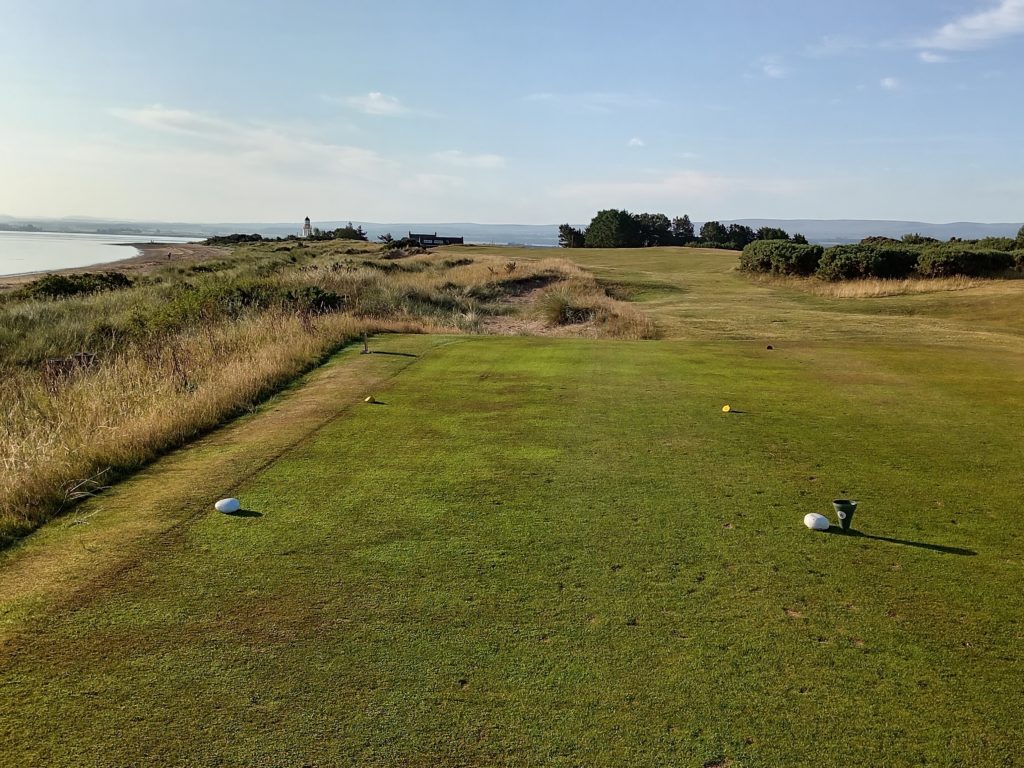
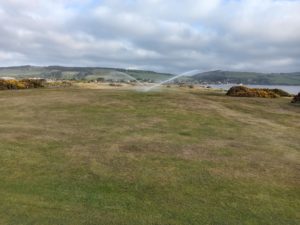
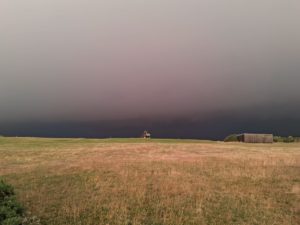
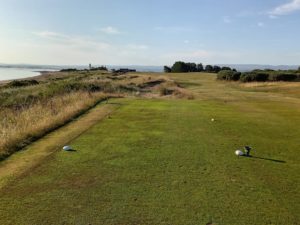


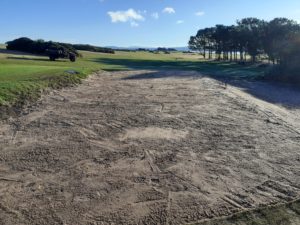 The 11th Medal tee extension is progressing well and we just have the teeing surface to turf and with a good grow in should be ready for use around May time. This new tee really opens up the dogleg aspect of the hole.
The 11th Medal tee extension is progressing well and we just have the teeing surface to turf and with a good grow in should be ready for use around May time. This new tee really opens up the dogleg aspect of the hole.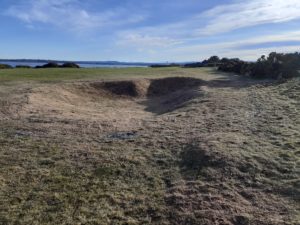

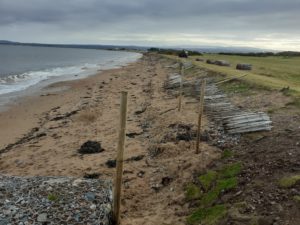
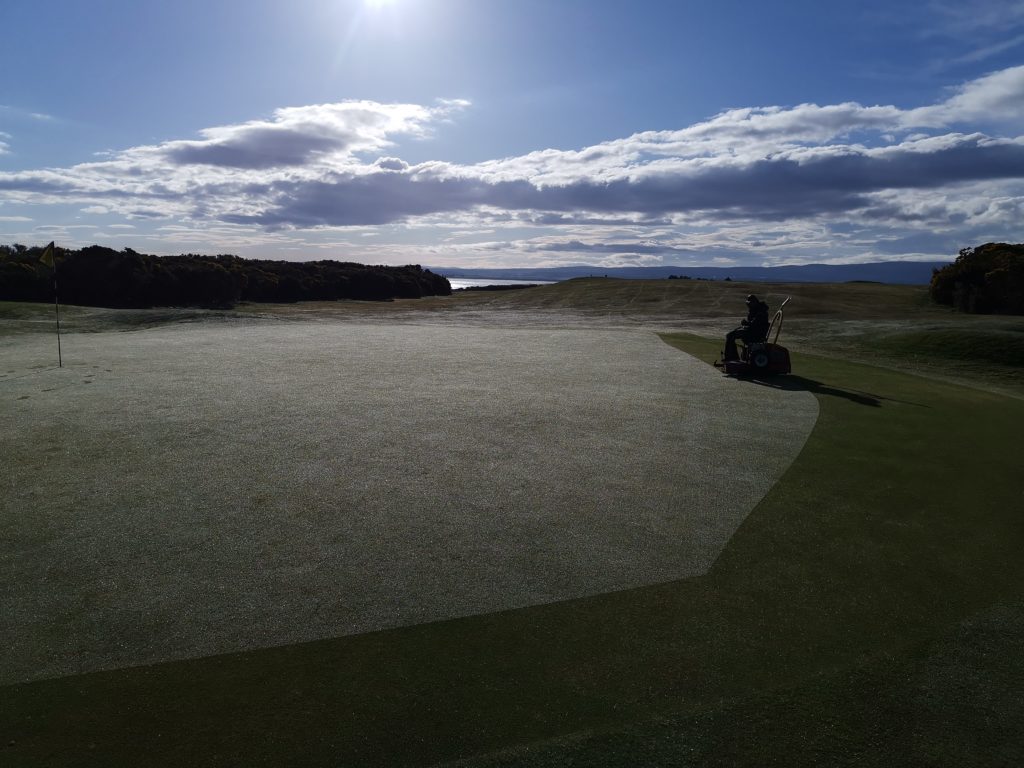
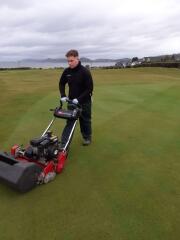
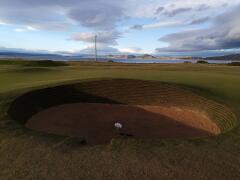 7th greenside bunker
7th greenside bunker Work on the greens took place in February when we gave them a solid spike followed by a Graden scarify and a heavy top dressing. This was quite aggressive at the time and happily they settled down fairly quickly after a week or two and much improved after another couple of dressings of sand. Growth has been extremely slow this year so far and we have only just lowered the mowers to 4.5mm. Our next target is a star spike and a little refinement with the verti cut units, a liquid spray of seaweed/molasses/humic acid and Nitrogen, some more light sand dressings and a Spring feed towards the end of the month. If we can get a wet day without any wind then our first application of wetting agent will go on.
Work on the greens took place in February when we gave them a solid spike followed by a Graden scarify and a heavy top dressing. This was quite aggressive at the time and happily they settled down fairly quickly after a week or two and much improved after another couple of dressings of sand. Growth has been extremely slow this year so far and we have only just lowered the mowers to 4.5mm. Our next target is a star spike and a little refinement with the verti cut units, a liquid spray of seaweed/molasses/humic acid and Nitrogen, some more light sand dressings and a Spring feed towards the end of the month. If we can get a wet day without any wind then our first application of wetting agent will go on.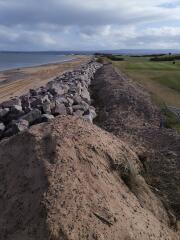 Coastal erosion. Note. Last Autumns high tidal surge coincided with one of the lowest atmospheric pressure readings since 1916. As you are aware plenty work has gone on at the 1st and 2nd holes over the past few weeks. Rock armour has been placed by GF Job at the 1st and 2nd tees to protect these most important areas. In between a short term fix of sand and Marram which was salvaged or reclaimed from the far end of the course and built up back to the exposed manhole covers and re gaining the core path once again. Two rows of chestnut fencing has been staked in to help protect this sand material and aid in any Marram regrowth. Subsequently and unfortunately last weeks high tide has taken a fair chunk of the sand away from the beach edge and some of the fencing will have to be moved inwards. . Long term this area can be re charged with sand and backed up with rock armour when enough funds are raised and become available. The core path area is to be soiled and seeded shortly to restore grass onto it and will be roped off meantime.
Coastal erosion. Note. Last Autumns high tidal surge coincided with one of the lowest atmospheric pressure readings since 1916. As you are aware plenty work has gone on at the 1st and 2nd holes over the past few weeks. Rock armour has been placed by GF Job at the 1st and 2nd tees to protect these most important areas. In between a short term fix of sand and Marram which was salvaged or reclaimed from the far end of the course and built up back to the exposed manhole covers and re gaining the core path once again. Two rows of chestnut fencing has been staked in to help protect this sand material and aid in any Marram regrowth. Subsequently and unfortunately last weeks high tide has taken a fair chunk of the sand away from the beach edge and some of the fencing will have to be moved inwards. . Long term this area can be re charged with sand and backed up with rock armour when enough funds are raised and become available. The core path area is to be soiled and seeded shortly to restore grass onto it and will be roped off meantime.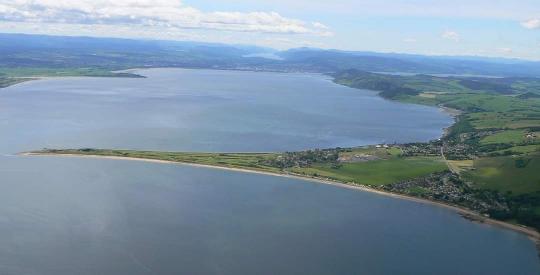
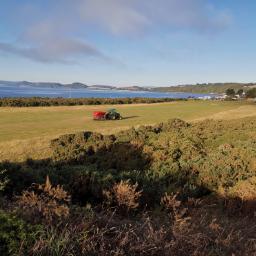 helps dilute fibre and in turn promote better soil characteristics for fine grass to tiller into. Some more selective sanding will go on.
helps dilute fibre and in turn promote better soil characteristics for fine grass to tiller into. Some more selective sanding will go on.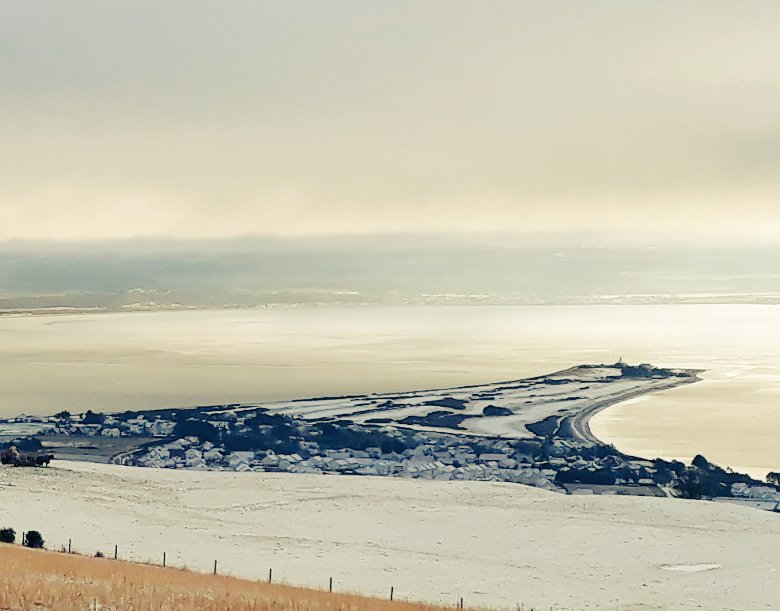
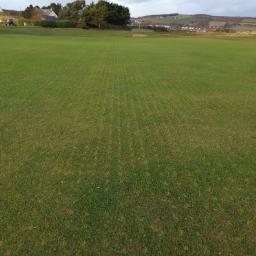
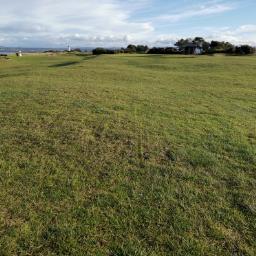
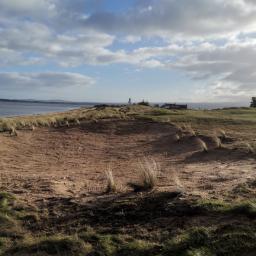 We also dug out the last group of whins on the left of the 4th fairway which gathered a lot of golf balls. We have created another sandscrape which will again catch the stray shot and make for a tricky recovery, meanwhile speeding up play.
We also dug out the last group of whins on the left of the 4th fairway which gathered a lot of golf balls. We have created another sandscrape which will again catch the stray shot and make for a tricky recovery, meanwhile speeding up play.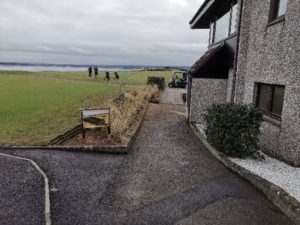
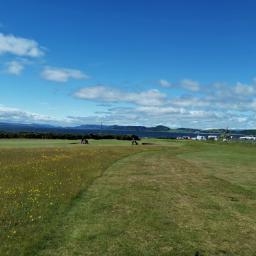
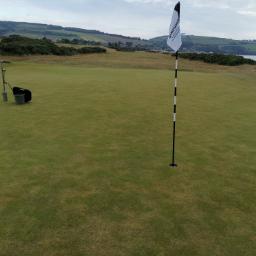 greens in an effort to re wet these bits. We also gave all the greens a close pencil tine down to 5″ to help enable any water to penetrate more evenly. We have more wetting agent to go on at the next opportunity which will hopefully bring back a full recovery. My thoughts are that the Meadow grass (Poa) component in the sward doesn’t like the dry weather and will always be susceptible in weather extremes and when the greens are pushed for speed. The fertility in the greens is also low and particularly the sandier greens which suggests that a light organic feed is imminent and would benefit things overall for the rest of the playing season. We are currently cutting at 3.7mm which is low enough for our site and greens make up but ultimately, if players want faster greens then the greens swards will require more Fescue grasses.
greens in an effort to re wet these bits. We also gave all the greens a close pencil tine down to 5″ to help enable any water to penetrate more evenly. We have more wetting agent to go on at the next opportunity which will hopefully bring back a full recovery. My thoughts are that the Meadow grass (Poa) component in the sward doesn’t like the dry weather and will always be susceptible in weather extremes and when the greens are pushed for speed. The fertility in the greens is also low and particularly the sandier greens which suggests that a light organic feed is imminent and would benefit things overall for the rest of the playing season. We are currently cutting at 3.7mm which is low enough for our site and greens make up but ultimately, if players want faster greens then the greens swards will require more Fescue grasses.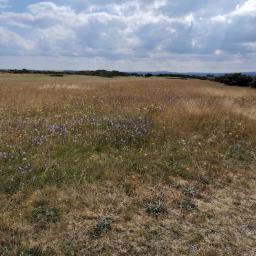 Our roughs have pretty much looked after themselves this summer with no summer cut required as they have thinned out with the dry weather. Plenty of colour in them with with dandelions and wild flowers here and there. A cut and collect will be done end of season.
Our roughs have pretty much looked after themselves this summer with no summer cut required as they have thinned out with the dry weather. Plenty of colour in them with with dandelions and wild flowers here and there. A cut and collect will be done end of season.